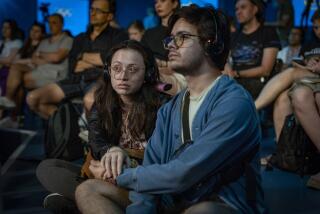Ukraine antigovernment protesters remain squarely planted in Kiev
- Share via
Reporting from Kiev, Ukraine — Borys Vitaliy was happily married with a successful recycling business when protesters began gathering in the Ukrainian capital’s Independence Square, also known as the Maidan, in November.
His consciousness raised, Vitaliy spent two days glued to the news, then left his hometown of Vinnytsia to join radical protesters bound for Kiev four hours away.
Since achieving their aim of forcing out President Viktor Yanukovich in a violent standoff, many of the activists have resumed normal lives, or headed off to fight the pro-Russia insurgency in the country’s east.
But Vitaliy remains in the square. His goal of fundamental political reform mostly unrealized — and his business, he says, taken from him by pro-Yanukovich leaders during the months of protest — he wiles away his days in a massive tent camp on one of Eastern Europe’s busiest thoroughfares.
“They call me Borys the Philosopher,” said Vitaliy, 39, standing shirtless in the noonday summer heat this week, wearing camouflage pants and the “Cossack haircut” of a flop of hair atop a shaved head. “And my philosophy is that, yes, there’s a war going on, but I need to be here to make sure the government continues to change. The revolution isn’t over.”
The war in Ukraine’s east has created streams of refugees seeking safety outside the combat zone. But Vitaliy represents a different type of dispossessed group. Known as the Maidanivtsi, it consists of hundreds, even thousands, of people who came to the capital during the Maidan protests and never left. They live as urban exiles under dark-green tents that spill across the square and into surrounding streets, a motley group that won’t pack up and that the government won’t remove.
The politics are particularly Ukrainian. Many, for instance, affiliate with the ultranationalist umbrella group known as the Right Sector and carry the self-appointed mantle of civilian defense fighter. But the issue of the Maidanivtsi also goes to a larger question: how best to commemorate historical events that were both tragic and triumphant, and in the place where they happened.
To their fans, the Maidanivtsi are a necessary presence, reminders of a turbulent past and watchdogs for an uncertain future. Should the government betray its citizens again, they say, these people are ready to spring into action.
To their critics, they are an urban blight--an irritating reminder of a difficult time--and even a national embarrassment. The real heroes, skeptics say, are off fighting insurgents, not sitting around a square.
With the battle against the separatists in the east offering many in Kiev a sense of national unity, the Maidanivtsi have been a rare divisive issue.
A tourist-stall vendor named Anatoly shook his head this week as he looked toward the group nearby. “They are unruly and they cause problems,” he said. “They should leave the square and let everyone get on with their lives.”
Up the street, David Savchuk, a 17-year-old music student who was active in the Maidan protests over the winter, echoed the thoughts of many of his fellow former protesters in questioning why the group remains.
“I understand their anger. But the big fight isn’t over here; it’s in the east,” he said. “They should go home.”
Many of the Maidanivtsi, however, say that isn’t an option. Documents and money were lost during the months of protest. Several tents bear the sign “Crimea,” indicating their occupants, if they returned home, would now find themselves on land since annexed by Russia. Others, like Vitaliy, say their wives left them during their months away.
And some say they just prefer the square. “We have food here, a good life here,” said Jaroslav Zolovkin, 28, a lifeguard from a town about an hour outside Kiev. “This is an ideal society.”
Though their setup appears haphazard, the Maidanivtsi are carefully organized, their tents grouped by hometown geography and membership organized under a strict hierarchy.
Outside one tent, a lean, muscular man who was missing several teeth identified himself as Commander Stavar. He said he was in charge of many of the units, declining to say whether the men had weapons, though observers think at least some do. “If the government doesn’t get rid of corruption and start leading, we are ready,” Stavar said.
But though handmade political signs and ultranationalist symbols are present — a mannequin of a communist hanging in effigy from a lamppost, the red and black flag of the Ukrainian Insurgent Army from World War II, neither of them helping to rebut the Kremlin’s pronouncements that the revolution was led by neo-fascists — most groups don’t pulsate with militant feeling.
Next to several of the tents, meat and fish could be seen cooking on grills. Pop music emanates from one tent. Another encampment boasts a makeshift gym.
“We really are not here to cause any trouble,” said Leonid, 18, who stood outside one tent next to an older man with a bullet wound in his heel earned in the protests. “But we don’t plan on leaving until the government is in order.” When parliamentarians recently left work after a short day without taking a critical vote, for instance, the Maidanivtsi herded them back to their offices.
In both their activist goals and their testing of the limits of the right-to-assembly, the Maidanivtsi can evoke the Occupy Wall Street movement. And many officials say privately that, as with the Occupy movement, they would like to see the square return to a normal state--signs of which, for all the makeshift memorials and revolution-era tires everywhere, have already begun, as food stands and tourists return and a new basketball court has been erected.
Yet forcibly removing the Maidanivtsi isn’t an option — that would create painful images in a country still reeling from the memory of protesters clashing with police. The newly elected Kiev mayor, former boxer Vitali Klitschko, said recently that he would like to see the Maidanivtsi leave but wouldn’t use force to remove them.
The group has also garnered some high-profile supporters. On a recent afternoon, Oleksandr Yarmola, the lead singer of the popular Ukrainian folk rock band Haydamaky, looked out at the Maidanivtsi and told The Times, “It’s a painful reminder to see them but let it be painful. People need to feel a little pain about what happened.”
Soon after, as Vitaliy chatted with friends outside his tent, a basketball belonging to teenagers playing at the new court bounced over a fence. Vitaliy scooped it up and lobbed it back to the boys.
“It’s nice to see tourists here again, to see children playing,” he said. “Hopefully it’s nice for them to see us too.”
More to Read
Sign up for Essential California
The most important California stories and recommendations in your inbox every morning.
You may occasionally receive promotional content from the Los Angeles Times.











